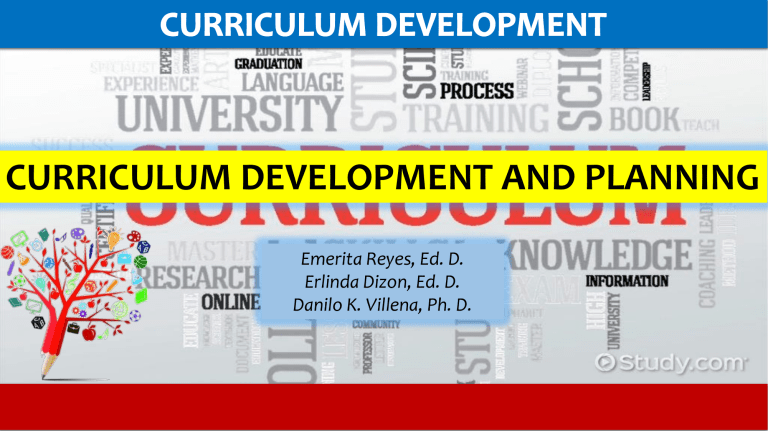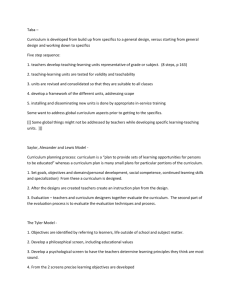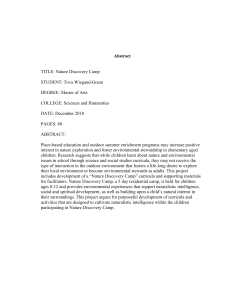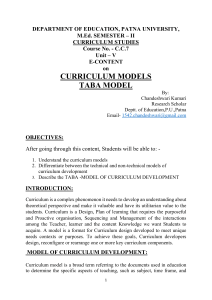pdfcoffee.com module-4-curriculum-development-and-planning-pdf-free
advertisement

CURRICULUM DEVELOPMENT AND PLANNING Emerita Reyes, Ed. D. Erlinda Dizon, Ed. D. Danilo K. Villena, Ph. D. Discuss the components of curriculum design and its organization that impart essential concepts, attitude, and skills to the learning experiences of the students. At the end of this chapter, students are expected to: • Identify the different models of curriculum development and planning; • Discuss the role of participants in curriculum development and planning; • Cite the curriculum planning challenges facing the Philippines education in this 21st century; • Name the three most important sectors in curriculum planning in the Philippines; • Explain the rationale for the curriculum review and planning of Philippine education towards the K to 12 program; and • Describe the goal-based model of curriculum planning in the Philippines using a diagram. Introduction • The tempo of societal changes and technological progress in our time is so fast that in order for schools and universities to cope up with this new innovations, they must participate in the educational and social revolution. • Thus, the curriculum as the foundation of the teaching-learning process, has to be engaged to the rapid societal changes and the new responsibilities for the new breed of Filipinos. • Therefore, the development of programs of study, learning and teaching resources, lesson plans, assessment of students, and even teacher education all based in curriculum needs changes. • According to De Coninck (2008), curriculum, more than ever before, is now viewed as being at the center of daily life and the responsibility of society as a whole. Models of Curriculum Development 1. 2. 3. 4. 5. 6. 7. 8. 9. AIM Model Taba’s Inverted Model Tyler’s Ends-Means Model The Oliva’s Model The Saylor and Alexander Model MacDonald’s Model Eisner’s Artistic Approach The Diamond Model Walker’s Naturalistic Model AIM Model - the most simple and clear model - starts with objectives and moves in the single direction - consists of both student activities and teacher activities - no foundation elements and no philosophy statement Objectives Content Materials Test Activities Student Activities Teacher Activities Taba’s Inverted Model - referred as inverted model - starts in the classroom with the teacher, as differentiated with other models - it has eight steps Step 1. Diagnosing needs using a needs assessment tool. Step 2. Formulating specific objectives, including concepts and attitudes to be learned, ways of thinking to be enforced, and habits and skills to be mastered. Step 3. Selecting content by carefully choosing topics, and writing a rationale to support each choice. Step 4. Organizing the content, sequencing. Step 5 and 6. Selecting and organizing experiences, ensuring that each activity has a definite function, and looking again at the development level of the students; what kind of activities is needed. Step 7. Evaluating the unit continuously, noting the students’ likes. Step 8. Checking for balance and sequence, ensuring that the activities provide opportunities to learn how to generalize, that the content sequence flows, that there is balance between written and oral work and research and analysis, that different forms of expression are possible, and that the organization is open-ended, allowing students to open up and talk. Tyler’s Ends-Means Model - this introduced a revolutionary idea to curriculum planning - start by deciding what purposes the curriculum is to have and then plan accordingly - today, this approach seems embarrassingly simple, but it was revolutionary at the time, since no curriculum developer has ever presented such model Ends Philosophy, Aims, Goals, and Objectives Means Curriculum Content and Activities - this model uses: • student as a source • society as a source • subject matter as a source • philosophy as a source • psychology as a source The Oliva’s Model - 1976, Oliva first introduced a curriculum development model - his target was to develop a model that was simple, comprehensive, and systematic Statement of Philosophy Statement of Goals Statement of Objectives Evaluation Implementation Design of Plan - 1992, he expanded his model as shown on the next slide - it is composed of twelve components - the squares on the model represent planning phases, the circles represent the operational phases Uses of the Model - 1st, this model offers a process for the complete development of a school’s curriculum - 2nd, this model can focus on the curricular components of the model to make programmatic decisions (components I to V and XII) - 3rd, a faculty can concentrate on the instructional components (VI to XI) - the exact strength of the model is its inclusion of foundations, societal and student needs The Saylor and Alexander Model - Galen Saylor and William Alexander (1974) introduced a model consisting of four steps Bases (external variables) Goals, Objectives, and Domains Curriculum designing feedback Curriculum Implementation Curriculum Evaluation Macdonald’s Model - by Macdonald and Leeper, 1965 - they perceived teaching as a personality system (the teacher) acting in a professional role and learning as a personality system (the student) performing taskrelated (learning) behaviors - it used a Venn diagram in illustrating relationships V. Concomitant Learning VI. Behavior Modification through Teacher Feedback VII. In-service Experiences VIII. Supervision Experiences IX. Pupil-teacher Planning Experiences X. Pupil-teacher Planning Experiences - strength: its presentation of the relationships among the model’s various elements Eisner’s Artistic Approach - by Elliot W. Eisner - it is the combination of his interests in art education and curriculum - comprises with seven components 1. 2. 3. 4. 5. 6. 7. The goals and their priorities The content of the curriculum The types of learning opportunities The organization of learning opportunities The organization of content areas The mode of presentation and mode of response The types of evaluation procedures The Diamond Model - formulated by Robert Diamond - starts with an assessment of need from the student, community and field of knowledge which is parallel to Taba’s - involves five stages 1. 2. 3. 4. 5. Assessment of Needs Statement of Goals Designing Curriculum Implementation Process and Assessment Revision Process if the need arises Benefits of the Model - easy to use, sequential and cost-effective (according to him) - can be used for design or redesign of courses, curricula, workshops and seminars in every subject area - politically sensitive Walker’s Naturalistic Model - this model used the deliberative approach in curriculum planning - Walker began studying what people actually do when planning curricula - he called it naturalistic because he wanted to show how curriculum planning is actually being done as to contest the other approaches that prescribe how it should be done - Walker’s naturalistic model is a descriptive model. First Phase: Second Phase: Third Phase: Platform Deliberation Creation of the Planned Curriculum Participants in Curriculum Development and Planning • • • • • • • Teachers Students Principals Parents Curriculum Specialists Superintendents School Boards Teachers - filling the main position in curriculum decision-making - they decide which parts of the curriculum, newly developed or on-going, to implement or stress in a particular class Students - their input is significant in its own right, accepting them to participate in curriculum developments also inspires them and encourages them to take responsibility for matters that concern them Principals - many principals are solely lacking in curricular and instructional expertise - when principals give attention to curricular activities, they often do so from a largely managerial perspective Parents - they support and influence the implementation of the curriculum by means of financial resources, an example is by their contribution for the public schools while in private schools is by means of payment of school fees - they may also help in monitoring and evaluating implementation Curriculum Specialists - they have broad knowledge in curriculum and are experts in creating and implementing curricula - In school, they may be the department heads or chairs of elementary or secondary education Superintendents - they are the system’s chief administrators - they respond to matters before the school board, initiate curriculum activity, start programs for inservice training of teachers, inform all district personnel of changes occurring in other schools, and process demands from outside the system for change or maintenance of educational offerings School Boards - they are the schools’ legal agents - responsible for the overall management headed by the local mayor or executive - in our system, school board plays only a secondary role in determining curriculum and policy; it is the national government and its national agencies which create the policy and mostly dictates the curricula to be implemented K to 12 Curriculum (basic info) - approved by President Aquino on May 15, 2013 - known as the Republic Act 10533 - Title: “An Act Enhancing the Philippine Basic Education System by Strengthening Its Curriculum and Increasing the Number of Years for Basic Education, Appropriating Funds Therefore and for Other Purposes,” otherwise known as the “Enhanced Basic Education Act of 2013” - took effect on June 8, 2013 - DepEd, CHED, and TESDA issue the rules and regulations to implement the provisions of the Act - Cycle: Kinder, 6-year elementary, 4-year junior high school, 2-year senior high school - Medium of Teaching and Learning: • Kinder to Grade 3: MTB-MLE • Grade 4 up: English and Filipino Curriculum Consultative Committee 1. CHED 2. TESDA 3. DOLE 4. PRC 5. DOST 6. Business Chambers K to 12 Standards and Principles (The curriculum shall …) 1. be learner-centered, inclusive and developmentally appropriate 2. be relevant, responsive and research-based 3. be gender- and culture-sensitive 4. be contextualized and global 5. use pedagogical approaches that are constructive, inquiry-based, reflective, collaborative and integrative 6. adhere to the principles and framework of MTB-MLE 7. use the spiral progression approach 8. be flexible enough to enable and allow schools to localize, indigenize and enhance the same based on their respective educational and social contexts Goal-Based Model of Curriculum Planning in the Philippines Outcome Goals of the K to 12 Basic Education Program 1. Be at par with international standards 2. Emotionally matured graduates equipped with skills 3. Address shortages or gaps in educational inputs 4. Broadened and strengthened stakeholders’ support 5. Improved internal efficiency 6. Improved system of governance in the Department 7. Improved quality of teachers Process Goals of the K to 12 Basic Education Program 1. Decongest and reform the basic education curriculum 2. Develop culture-sensitive, culture-responsive and developmentally appropriate print/non-print online learning resources 3. Conduct in-service training for teachers 4. Focus on integrated instruction 5. Universalize kindergarten by 2012 6. Institutionalize school-based management for school empowerment 7. Institute reform in assessment framework 8. Address basic input shortages 9. Promote good education governance 10. Pursue legislation 11. Formulate transition management plan 12. Identify K to 12 model schools per region and per specialization Three Most Important Sectors of Society that give direct input to the improvement of the curriculum: 1. Academe (institutions) 2. Industries (both public and private companies) 3. Government and its Agencies - End of Lesson Submission of Module 4 Next Meeting



